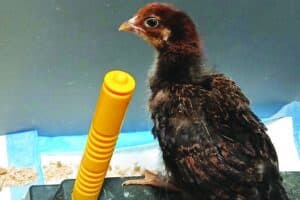They’re dead.They’re all dead.Margaret had been worried about the health of our beehive; an alarming number of dead bees were piling up outside the hive. But when she had opened the hive a few weeks earlier, there were plenty of active bees inside.This time when she opened the hive, there was no activity, no buzzing. They were all lost. A few days later, other, presumably wild, bees ó robber bees, Margaret called them ó came to investigate the open hive and steal what honey they could, but they had no intention of sticking around.It was our first winter with the bees. Experts we consulted agreed that the bees were likely victims of the varroa destructor, or varroa mite. The tiny parasites likely decimated our bee population to the point where the survivors couldn’t handle the cold and froze to death.”Varroa destructor is aptly named and is the cause of a tremendous percentage of colony losses annually, especially for new beekeepers,” the website of the Colorado Beekeepers Association states. “In addition to feeding on the hemolymph (bee blood) of the developing bees, varroa transmit a number of fatal viruses, for which there is no treatment.” (Those viruses include such grim names as Deformed Wing Virus, or DWV; Chronic Bee Paralysis Virus, or CBPV; and Acute Bee Paralysis Virus, ABPV.)Our hive seemed to be thriving over the summer. But, Purdue University Extension warns, “Heavily infested beehives can look very healthy and produce good honey crops, only to dwindle and die during fall or winter.” Margaret was aware of the varroa threat and had treated the hive, but the effort obviously hadn’t been enough. Despite the setback, she wasn’t ready to surrender; she quickly made plans to secure new bees this spring. In hopes of not repeating the disaster, she also signed up for an online class on mite prevention through Rocky Mountain Bee Supply in Colorado Springs.The instructor was Dann Purvis, who lives in the Springs and used to have a famed honeybee breeding and research business in Georgia; he’s even known for a distinct line of bees known as the Purvis Goldline honeybee.First of all, he said, “Don’t beat yourself up if you have a hive that dies. Ö Well, hives die. It happens.”Varroa mites, he told the class, are simply a fact of life for beekeepers. If you’re breeding bees, you’re breeding varroa mites, and you just have to live with that and have a strategy for it, he said.He discussed two strategies. One is the use of “hard,” inorganic chemical treatments such as Apivar and Apistan. While widely used, Purvis worries those are too harsh for the bees; instead, he favors organic, more natural substances. At the top of his list is oxalic acid.”Oxalic acid is a naturally occurring compound found in plants, such as rhubarb, kale, beets and spinach,” according to the Penn State Extension website. ìAs a chemical for mite control, oxalic acid can be used in two formulations: vapor and dribble.”Purvis discussed the vapor method, which includes buying a vaporizer. He recommended a specific brand, Varrox, which is manufactured in Switzerland but is available at Rocky Mountain Bee Supply. Margaret said the method seems to be “the most work and hardest to use,” but it also is described by Purvis as the most effective.One less effective treatment, but one used commonly for monitoring the mite situation, is the powdered sugar roll. It involves coating a portion of the bees in powdered sugar; that doesn’t hurt the bees, but it does make the mites slide off so you can do a count. Experts say before you tackle your mite problem, it’s important to know the extent of that problem.Purvis also had encouraging news for the class. While there have been alarming reports for years of declining populations of honeybees due to mites and environmental pressures, he believes the bees are coming back. And he credits the hobbyist, or backyard beekeeper. Decades ago, an overwhelming majority of honeybees were in the hands of professional beekeepers. Now that has reversed. And he said the hobbyists are adding to both the diversity and numbers of honeybees.”The hobbyists are really making a difference,î he said.That cemented Margaret’s decision to proceed with getting more bees and starting anew.”To me, that was very encouraging,” she said. “It makes me want to keep trying to help them.”





